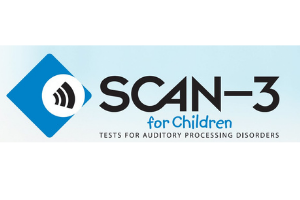Description
SCAN-3 is a valid and reliable battery of tests to help identify auditory processing disorders in children.

SCAN-3 is a valid and reliable battery of tests to help identify auditory processing disorders in children.
SCAN-3 is a valid and reliable battery of tests to help identify auditory processing disorders in children.
Robert W. Keith, PhD
Overview:Battery of tests to identify auditory processing disorders in children
Age Range:Children 5:0—12:11 years old
Scoring Option:Manual scoring
RTI Tiers:Screening-1; Diagnostic-2 and 3; Supplemental-3
Scores/Interpretation:Screening tests: norm-based criterion-referenced scores; Diagnostic tests: scaled scores, percentile ranks; Ear Advantage scores for all tests except Gap Detection
Publication Date:2009
SCAN-3 provides you with a valid and reliable test battery to help identify auditory processing disorders and describe their impact in daily life. Screen and diagnose auditory processing diffi culties with one co-normed battery of tests.
The SCAN-3 test battery includes:
Ear advantage scores are provided for all tests except Gap Detection.
Updated norms and continuous normative scores are provided across SCAN-3 Child and Adolescent/Adult editions so that you can continue to monitor progress as the child ages out of the SCAN-3:C for children.

Frequently asked questions follow. Click on a question to see the response.
Are the SCAN—3 tests (both Children and Adolescents/Adults) screening or diagnostic tests?
Test Content
Why are there 3 S/N (signal-to-noise) ratios on the SCAN-3? How do I use them?
Administration
When should I choose to use the supplementary subtests of the SCAN-3?
A student was given the SCAN-3 and the educational team was unaware that he had a concussion at the time. He has now been cleared by the medical staff and the team feels that the SCAN-3 administration is inaccurate and invalid. When can we re-administer the test without compromising our result?
Scoring
If the child is meant to say ‘waste, cage’ and they say ‘waste’ only, mark ‘waste’ as correct and ‘cage’ as incorrect (no answer). What if the child responds with only ‘cage’ (i.e., only gives the left ear response)? Is this marked correct or incorrect?
Interpretation
I want to make sure I’m interpreting my SCAN-3 results correctly. What type(s) of information do you have to help me?
Can the SCAN-3 be used to try to determine whether the finding on dichotic testing is from an auditory processing disorder (APD) or cognitive disorder?
What criteria can be used to diagnose a child as having an auditory processing disorder (APD)?
Manuals, Record Forms, & Manipulatives
On the Audio CD, The Filtered Words (FW) subtest sounds quiet. Is there a problem with the CD?
Why does the FW test appear to be so quiet?
The dB level of the stimuli in the Filtered Words subtest sounds noticeably “quieter” than the other subtests.
Technical Information
What settings should be used to be sure that the person being tested can hear the stimuli well?
What is an acceptable background noise level in the room where I administer the SCAN-3 and still get valid test results?
I put the audio CD into my CD drive and the track labels seem to be incorrect. Do I have the wrong disk?
In the protocol instructions, there is a figure/ground subtest that evaluates each ear individually and that there is a CD and earphones involved but where do you get these earphones and where do they plug in?